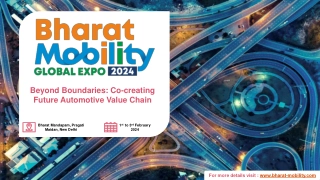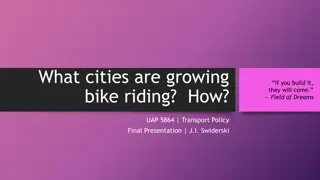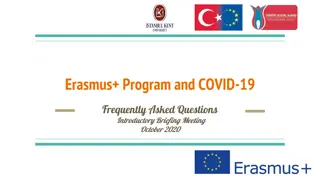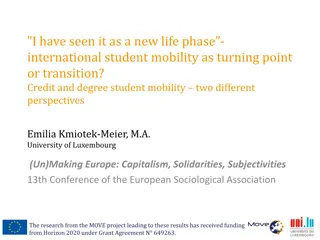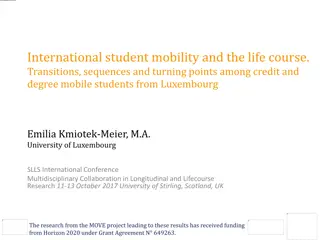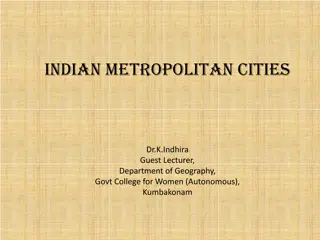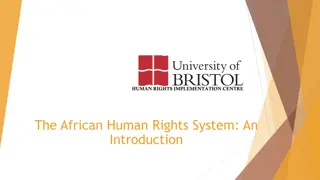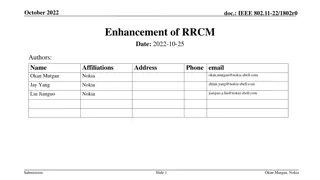VREF MOBILITY AND ACCESS IN AFRICAN CITIES (MAC) NEXTGEN RESEARCH FORUM
This presentation delves into the drivers of pedestrian decision-making processes in Greater Accra Metropolitan Assembly, exploring active transport infrastructure, pedestrian behavior theories, and regulatory environments. The focus is on improving pedestrian safety and urban mobility in African cities.
Download Presentation

Please find below an Image/Link to download the presentation.
The content on the website is provided AS IS for your information and personal use only. It may not be sold, licensed, or shared on other websites without obtaining consent from the author.If you encounter any issues during the download, it is possible that the publisher has removed the file from their server.
You are allowed to download the files provided on this website for personal or commercial use, subject to the condition that they are used lawfully. All files are the property of their respective owners.
The content on the website is provided AS IS for your information and personal use only. It may not be sold, licensed, or shared on other websites without obtaining consent from the author.
E N D
Presentation Transcript
VREF MOBILITY AND ACCESS IN AFRICAN CITIES (MAC) NEXTGEN RESEARCH FORUM Pedestrianizing Cities: Examining Pedestrian Behaviour In Accra Presenter Jonathan Otumfuor Asante 1 17-Feb-25
Outline of presentation Background Problem statement Aim and Objectives Frameworks Findings Analysis Yet to do 2 17-Feb-25
Background o Active transport direct benefits for the individual and collective benefits for urban populations (Su and Bai, 2021). o Active transport the basis for sustainable city (Ariffin and Zahari, 2013). o SDG 11 Target 11.2 access to safe, affordable ..for all (UN, 2016). 3 17-Feb-25
Background o Pedestrianisation Improving the livability of cities and reducing the damaging impacts of motorised traffic (Sinnett et al., 2011; Soni and Soni, 2016; Jensen et al., 2021). o Germany, Switzerland, and Norway - develop transport systems to accommodate other road users. the case of Nairobi, Addis Ababa and Lagos. o Improved Intra urban transport furniture (footbridges, traffic lighting, bollards, streetlights, refuge islands) o Relationship between built environment and pedestrian mobility (Yin and Zhang, 2021). 4 17-Feb-25
Problem statement o Pedestrians have the legitimacy (Road Traffic Regulations LI 2180, 2012) to use roads safely (Sam, 2021), conveniently (Starkie, 2020), freely, and without unreasonable delay (Zahir, 2007). o Increasing pedestrian crashes (WHO, 2021). o 918 pedestrian injured while 255 pedestrian died in 2022 (NRSA, 2023). o Limited evidence to explain pedestrian behaviour and decision making in the usage and non-usage of transport infrastructure Ghana. 5 17-Feb-25
Aim To analyse the drivers of decision-making processes underlying pedestrian behaviour in Greater Accra Metropolitan Assembly. Research questions 1. What is the nature and availability of active transport infrastructure in GAMA? 2. Does the active transport infrastructure meet the demands of pedestrians? 3. What informs the pedestrian to use or not to use the existing NMT infrastructure? 4. What influence pedestrians to make optimal decisions in the usage of NMT infrastructure? 5. What does the regulations and laws require the pedestrians to use the NMT infrastructure? 6. How does the regulatory environment affect the pedestrian behaviour and decision making? 6 17-Feb-25
Frameworks o Pedestrian Level of Service (PLOS) measure to evaluate street facilities and infrastructure for pedestrians. o Normative Pedestrian behaviour theory (Hoogendoorn, 2001). o Theory of reasoned action (Fishbein and Ajzen, 1975). o Built Environment Effect (Khan et al., 2014). 7 17-Feb-25
Preliminary Findings Research Question 3 Characteristics of respondents How long do you travel without a car? Less than 500 meters 500 meters 1km 1km 2km 2km 3km 3km and more Sex of respondents Total 38% Less than 15 years 0% 4% 4% 0% 0% 4 62% 16 25 years 4% 12% 0% 2% 0% 9 26 35 years 4% 8% 8% 8% 0% 14 36 45 years 6% 8% 4% 8% 6% 16 Male Female 46 55 years 0% 4% 4% 0% 0% 4 56 years and above 2% 0% 0% 0% 4% 3 Source: Fieldwork (2023). 8 17-Feb-25
Preliminary Findings Research Question 3 Frequency of pedestrian walkways Are there enough pedestrian walkways in your neighborhood? How long do you travel without a car? 22% 30% Yes No Total Less than 500 meters 6% 10% 16% 500 meters 1km 4% 32% 36% 48% 1km 2km 8% 12% 20% 2km 3km 6% 12% 18% 3km and more 10% 10% Often When it is available Not often Total 34% 66% 100% Source: Fieldwork (2023). 9 17-Feb-25
Preliminary Findings Research Question 3 The built-up environment Friendiliness of Pedestrian trails in the neighbourhood YES NO In some areas Status of sidewalks in the neighbourhood 28% Exposes you to danger 16% 38% 52% PEDESTRIAN SIGNALS 16% Narrow 10% 84% 30% 70% BICYCLE TRAILS 26% Occupied by traders 30% Friendly to walk 22% 78% TREES Well maintained Not maintained 0% 5% 10% 15% 20% 25% 30% 35% Source: Fieldwork (2023). 10 17-Feb-25
Preliminary Findings Research Question 3 The built-up environment Non-Usage of Footbridge N Percentage Non-Usage of Zebra Crossing 14% Far from my crossing point 23 27% 22% Too long to use 15 17% Markings are not clear 19% 45% No footbridges in my area 34 40% Not at my crossing point No zebra crossing Not safe 14 16% Drivers won t give way Source: Fieldwork (2023). 11 17-Feb-25
Yet-to-do o Map out of transport infrastructure in GAMA o Pedestrian count o Street auditing o Qualitative data collection Pedestrians Stakeholders 12 17-Feb-25
References Ariffin, R. N. R & Zahari, R. K. (2013). Perceptions of the urban walking Environments. Asia Pacific International Conference on Environment-Behaviour Studies University of Westminster, London, UK, 4-6. Damsere-Derry, J., Ebel, B. E., Mock, C. N., Afukaar, F., & Donkor, P. (2010). Pedestrians' injury patterns in Ghana. Accident; analysis and prevention, 42(4), 1080 1088. Litman, T. (2023). Evaluating Active Transport Benefits and Costs Guide to Valuing Walking and Cycling Improvements and Encouragement Programs. Victoria Transport Policy Institute. Transportation Research Record 1441, 134-140. Su, J., Sze, N. N., & Bai, L. (2021). A joint probability model for pedestrian crashes at macroscopic level: Roles of environment, traffic, and population characteristics. Accid. Anal. Prev. 150, 105898. 13 17-Feb-25
Asante 14 17-Feb-25



